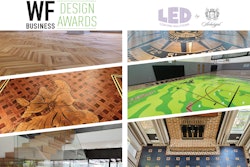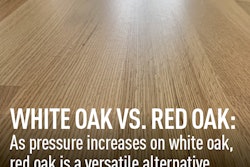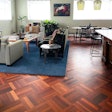

I started my business from scratch back in the early '80s. I was new to the business, and when you start from scratch, you have nothing to sell but price. You have no reputation and no history. I was basically slab-hopping and trying to set up relationships with builders. Since they're price-oriented (to put it nicely), builders are the first ones who are going to take a chance on you.
We were basically just banging down 2¼ strip and gluing down oak shorts at the time, but I knew I wanted to do something different. I always knew I wanted to be the best at something-not the biggest, fastest, cheapest or most expensive-just the best. We worked for years to refine our process for installing, sanding and finishing. Along the way, if we got a chance to do something a little different, like a border or a herringbone floor, I'd take a picture of it. That was the start of our company's portfolio.
As our business with the builders grew, eventually we'd get jobs where the builder would tell us to work with the homeowner directly because the customer wanted something different. We started building our word-of-mouth referral network that way. They'd say, "The builder recommended you, but what can you do?" That's when I would bring out the portfolio.
As the jobs got nicer, we'd do a really beautiful job, and I'd have these really lame photos that didn't do the floor justice; you couldn't discern the quality of the floor because the photography was so bad. I realized that if I was going to pitch this as a high-quality floor, I was going to have to get some professional photography to reflect the quality of the floor. We were working up the totem pole of builders and starting to work with designers, and designers are very visual people. You can talk concepts with borders or patterns, but it doesn't compute; they have to see something.
Initially, we had to cull through several photographers, but we were lucky to find one that really fits our needs, and we've been using him for years now. Photographers are used to shooting room shots with very little floor, so I go to every shoot and we discuss the shots I want. Now he understands that our floor is the hero in these shots, not the beautiful cabinets or paneled walls.
I used to think a completely vacant room would show my floor the best, but I quickly learned that's kind of a boring shot. Now, we sometimes wait years to be sure the designer's final touches are complete or for the owners to have their art collection displayed properly, and it's worth waiting for. Right now we're waiting to take photos of a job we installed two years ago.
Some of our clients won't even allow cameras or cell phones with cameras on the job, but if we have a project I would like for our portfolio, I approach the client early on in the job. I discuss how it's going to be a beautiful job and I'd love to have it be a part of our portfolio. They like that, and I also emphasize that their anonymity will be preserved. Once the job is done and we have the photos, I create a nice binder with prints for the owner, the designer and the builder, and I also give them a disc of the files. It's a nice thank you for the job and for allowing us to photograph it.
Before we had our Web site, carrying around my portfolio of prints was very important. Now I consider our Web site our portfolio. If I'm meeting a client off-site, we'll go over the online portfolio. If they are in our showroom, they've already been to our Web site; that's probably what's driven them to us.
Today our business caters to designers, and the only builders we work with are higher-end builders with projects that can last several years. Our portfolio has been a crucial part of building our business to this level-a far cry from our slab-hopping beginnings.
Business Briefs

Doing it All ... Or Not
If I want it done right, I have to do it myself!" Sound like you? "When I try to delegate, it always seems to backfire." Also familiar? To grow your business and keep your sanity, you simply have to get consistent, top-quality results through your employees. Disastrous delegation is caused by mismatched assumptions: You thought you asked for this, they thought you meant that. Three keys:
- Define the results you want (how much, when, where, etc.). Quantify everything, don't say "ASAP."
- Specify the process. Create a detailed checklist that will get the results you expect. Don't assume anything.
- Write everything down! Put it in a binder and make sure everyone knows they're to follow the written procedures.
Contractor/owners should be spending no more than 20 percent of their time on day-to-day tasks. Do it right, and you'll free yourself to run your business instead of having your business run you.
Jayme Broudy is the founder/principal of Contractor's Business School. Complete Jayme's free Business Analysis by going to www.contractorsbusinessschool.com/assessment or call 800/527-7545 to get the free CD "10 Key Strategies to Build a Business that Works."

































